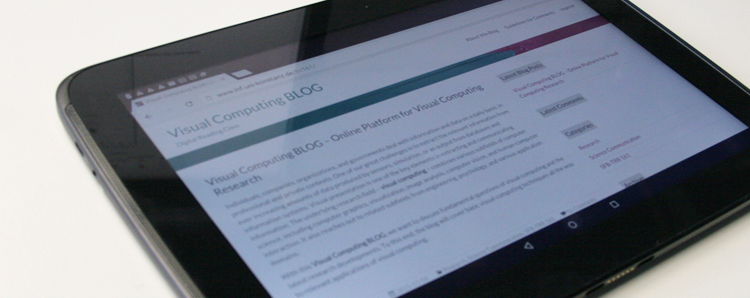Individuals, companies, organizations, and governments deal with information and data on a daily basis, in professional and private contexts. One of our great challenges is to extract the relevant information from ever increasing amounts of data produced by sensors, simulation, or as output from databases and information systems. Visual presentation is one of the key elements in extracting and communicating information. The underlying research field – visual computing – combines various subfields of computer science, including computer graphics, visualization, image analysis, computer vision, and human-computer interaction. It also reaches out to related subfields from engineering, psychology, and various application domains.
With this Visual Computing BLOG, we want to discuss fundamental questions of visual computing and the latest research developments. To this end, the blog will cover basic visual computing techniques all the way to relevant applications of visual computing.
The blog is linked to a new Transregional Collaborative Research Center SFB/Transregio 161, funded by the German Research Foundation (DFG). The project is entitled “Quantitative Methods for Visual Computing”. The web site of the SFB/Transregio 161 (SFB-TRR 161 in short) is: www.sfbtrr161.de. There, you will find project-specific information. In this blog, we will cover research from the SFB/Transregio 161, but also visual computing in general.
With the Transregional Collaborative Research Center, we plan to establish quantification as a key ingredient of visual computing research, because as yet there is no overarching tradition of quantitative methods for visual computing. Quantification will ameliorate the reproducibility and predictability of visual computing results. We expect to develop quantitative models and measures that will allow us to quantify the effectiveness of visual computing techniques and their interaction with the user, as well as the efficiency of algorithms and systems. New models and adaptive algorithms, which facilitate quantitative control and configurability of visual computing techniques, will be a key to improving the predictability of visual computing methods and advancing the applications of visual computing. With this project, we are confident that we will advance visual computing research and its applications into the challenging direction of quantification. In the long-term, we see a great impact on our research community – in the form of fundamental quantification methods and respective techniques for visual computing – and beyond, for example, in the form of improved and reliable technology for visually oriented data analysis, communication, and policy making.
The Transregional Collaborative Research Center has three partner institutions with a long-standing focus on visual computing research: the University of Stuttgart, the University of Konstanz, and the Max Planck Institute for Biological Cybernetics in Tübingen.


